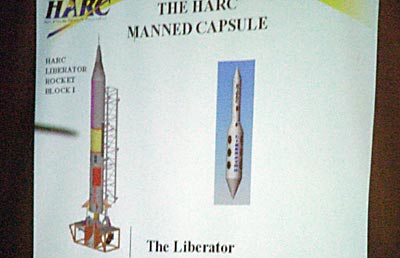Enter the LiberatorA new team is making a late bid to win the X Prizeby Jeff Foust
|
| “Actually, a lot of the vehicle’s already built,” Pickens said. “We’ve got tanks, we’ve got interstages, we’ve got thrusters, we’ve got engines.” |
To keep things simple, Pickens said they elected to adopt a “very traditional approach” with a capsule atop a rocket. The rocket will lift off from a barge over 300 kilometers offshore in the Gulf of Mexico. That airspace, Allison explained, is controlled by Eglin Air Force Base, and is relatively inexpensive to use. Allison noted that range costs for the launch will be “under an order of magnitude cheaper” that the $80,000 range fees quoted by Wallops in Virginia.
The capsule under development will feature an escape tower actually integrated into the capsule design; the tower will have either a solid motor or a hybrid engine based on previous designed by HARC and Orion. They said that they plan to test a version of the capsule on a “Block 1” version of the Liberator on an unmanned flight to about 40 kilometers.
One key factor that makes the Liberator credible is the background of HARC and Orion. HARC has worked for several years on balloon-launched rockets, or rockoons. In October 2000 the company made a bid to win the Cheap Access to Space (CATS) prize with a rockoon launched from a barge in the Gulf of Mexico; the launch failed when the rocket engine failed to ignite after being released from the balloon 25 kilometers high. HARC members were also involved with Project HALO (High Altitude Lift Off), a rockoon effort run by HAL5, the Huntsville chapter of the NSS, that set an amateur rocket altitude record in May 1997 of over 65 kilometers.
| The project has been going on for an unspecified period of time, but kept quiet until there was something to show. “We don’t hype until it’s ripe,” quipped Allison. |
Pickens also has experience beyond Orion Propulsion. After working for Space America, Pickens was hired by Scaled Composites to be the propulsion systems developer for SpaceShipOne. “It was a real good opportunity to see the issues with the big hybrids,” he said. He noted that initially Scaled planned to develop the propulsion system in house, but later decided to outsource part of the development, pitting four companies, including HARC, HMX, EAC, and eventual winner SpaceDev in a competition to develop the propulsion system.
No hype until it’s ripe
The decision to announce the existence of the Liberator project at the conference was made fairly late, Allison said. They had planned to reveal the project in a “rollout event” still scheduled for next month in Huntsville, where HARC and Orion are located, but Allison said they decided just a few days earlier to announce the vehicle at the Space Frontier Conference before an interested audience of fellow entrepreneurs and space advocates. The project has been going on for an unspecified period of time, although HARC and Orion elected to keep the wraps on the vehicle until they had something to show. “We don’t hype until it’s ripe,” quipped Allison. (As of late Sunday, the home page of the HARC web site featured the message “News Flash!! HARC to make big announcement soon! A New Dawn for Space Tourism - STAY TUNED !!!” but no further details.)
The project still has a lot of work ahead of it. Allison said they had not yet submitted their X Prize application and registration fee, and also had yet to initiate the launch license application process with the FAA’s Office of the Associate Administrator for Commercial Space Transportation (AST). While the cost to develop the vehicle is relatively modest—an estimated $4.5 million—Allison also said they are still working on raising the funding.
Allison and Pickens acknowledge those and other hurdles they have to overcome before they have a shot of claiming the X Prize by the end of next year. “It’s going to be down to the wire,” Pickens said. By then, of course, one of a number of teams may have already claimed the $10 million. If not, though, this late bid to win the X Prize could turn out to be right on time.
